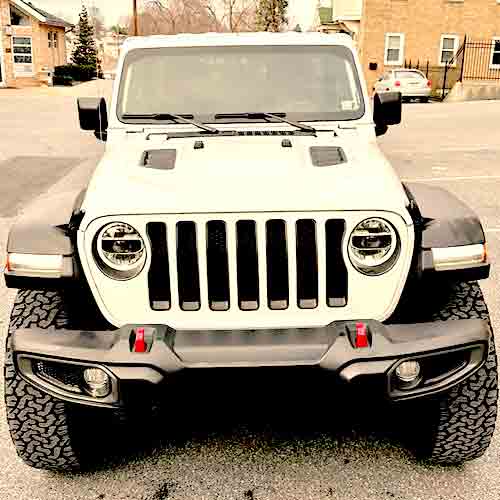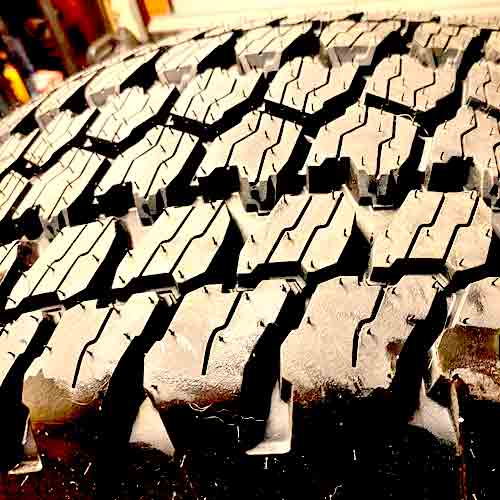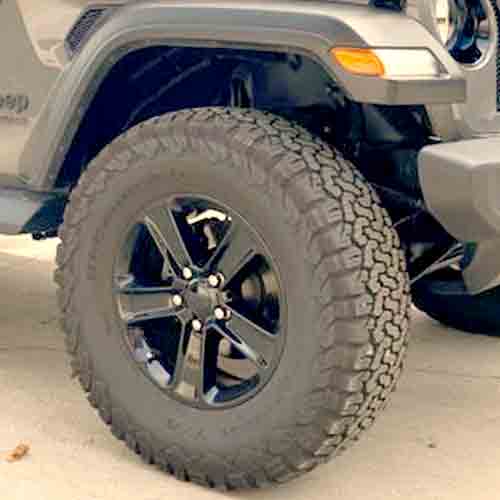Goodyear Wrangler AT/S and the BF Goodrich KO2 are both highly-regarded all-terrain tires. They offer excellent performance on a variety of terrains. However, there are certainly some factors to consider when choosing between the two. Let me examine all of them for you.

With decades of experience in tire engineering, I can say with confidence that out of both tires, you’d see a better grip (on both wet and dry environments), on Wrangler A/TS. Moreover, the tire also gives better fuel economy and comfort levels. On the other side, the BF Goodrich KO2 gives better tread life, and shines on all types of terrains off-road. Both tires with 3PMSFR provide similar winter traction as well.
Table of Contents
Tread Appearance
The Goodyear A/TS has a very unique design.

This tire is basically composed of 4 ribs, where the outer two (shoulders), may look like two additional columns of blocks, but they are not (as lugs are joined up from underneath).
All these lugs have similar features, they are seen with full depth siping, and sharp chamfered edges, and off-set sides forming biters.
They also make 3 longitudinal grooves, with the inner one being narrower and zig-zag geometry.
The overall design of the tire is very on-road oriented. That’s why you don’t see aggressive lateral grooves in there, and it’s shoulder lugs with missing traction scoops (they are not staggered).
Moreover, the tire also doesn’t give any sidewall biters, so that reduces the off-road traction capabilities, especially if you compare it with a tire like KO2.
On the other hand, the BF Goodrich KO2 features a more rugged look.

It features 3 interconnected ribs in the middle creating a web of grooves that twist and turn around in all directions, providing amazing off-road traction.
Basically the lugs making these grooves form a a soup of lateral and circumferential bite giving this tire grabbing abilities in all directions.
Moreover, with a continuous design they also get to offer above average grip on pavements as well, so its a win win.
Though same can’t be said about the shoulders, as they are much more aggressive. But you do get amazing off-road capabilities, no doubt about that.
They have powerful traction notches of two different designs, staggered outer edges with big traction scoops and very biting sidewall lugs which work at full potential with lowered air pressure.
Durability
All-terrain tires are made tough through their internal construction, for the most part. Though their outer rubber also further adds to that no doubt. And considering both, the BF Goodrich KO2 comes on top.
The tire has a tougher rubber skin, and internally it has 3 ply polyester casing with 2 belts (made of steel), and 2 spirally wound nylon cap plies.
The Goodyear Wrangler A/TS on the other side, yields on 2 ply sidewalls.
Moreover, the tire also has thinner sidewall lugs so it does not protect the weakest part of the tire in a better way, comparatively.
Sizes Specs
On the other hand, the Goodyear Wrangler A/TS comes in 15 to 20 inches with following specs:
- Speed ratings: R and S
- Load ratings: SL, C, D and E
- Weight range: 30 to 60 lbs
- Tread depth: 13 to 16/32″
- Ratings: No 3PMSFR
- Warranty: None
The BF Goodrich KO2 has following features, on it’s 90 sizes coming in with 15 to 22 inches.
- Speed Ratings: R, S, or Q
- Load ratings: C to E
- Weight range: 35 lbs to 67 lbs
- Tread Depth: 15/32″ on all sizes
- Winter ratings: M+S & 3PMSF
- Warranty: 50k miles on all
Dry Performance
To effectively evaluate the dry performance of an all-terrain tire, we need to consider traction, steering, and cornering ability. Let’s consider each of these factors separately.
Dry Grip
The footprint of a tire along with section width, are the main dimensions that affect grip, and considering both it can be seen why the Goodyear Wrangler A/TS yields better traction values here.
It’s lugs are placed longitudinally, so moving straight they show up with shorter braking distances, and faster acceleration times (this placement of lugs basically makes a more consistent rubber to road connection).
In case of KO2, that connection, gets broken more often with wider lateral grooves.
Handling Performance
Sideways grip, also known as lateral traction, is a measure of a tire’s ability to corner. And this depends on two main things, how much shoulder lugs meet up with the ground, and steering response.
The BF Goodrich KO2, although features a very balder design towards the sides, it’s rigid composition keeps the lugs stable and so they provide good enough steering response.
But still the movement of the lugs is still less on Wrangler A/TS. So this tire gives better balance between under and over steering and with it handling efficacy.
Wet Road Traction
Wet roads necessitate a tire with a balanced approach to both grip and hydroplaning resistance. Both of these are achieved through efficient water removal. Let me explain.
Wet Grip
Wet grip is largely provided by sipes, which are slits basically, soaking up the water particles by flexing, that’s why with a firmer rubber composition, the BF Goodrich KO2 is not able to provide good enough traction, (even though you get a lot of siping on its tread).
In comparison, the Goodyear Wrangler A/TS gets a better water wiping abilities with its softer tread, allowing those sipes to expand and contract in a better way, slurping water with more ease.
Aquaplaning
Aqua, or hydroplaning happens when water comes in between the tire and the road, and it starts to float. That’s why with higher speeds, a tire becomes more vulnerable to that, as water is not able to gush out in time.
Though in case of these two tires, that’s not the case, the Wrangler A/TS features more tread depth and a softer compound which creates negative pressure and throws the water out in time.
While the BFG KO2 provides you with interlocking structure with wider grooves, doing the same, even though the lugs aren’t that flexible here.
Tread Life
The three crucial factors affecting tread life are rolling resistance, tread depth, and composition. And considering all it can be seen why the BF Goodrich KO2 gets to be better here, as it features a harder compound which is less prone to faster burning.
The Wrangler A/Ts on the other end, although gets to be slightly better in terms of tread depth, its softer compound still wears off faster in comparison.
(Tread depth is better for longevity, because deeper voids take more time to reach down to the legal 2/32″ level).
Fuel Usage
The fuel efficiency of a tire is affected by its rolling resistance, which can be influenced by the tire’s weight and tread composition too.
And considering all, it can be explained why BF Goodrich KO2 is not able to provide as great of a MPGs as the Wrangler.
KO2 basically comes with a heavier construction, and so it require more energy to roll in comparison. Whereas on Goodyear A/TS, you get a lighter structure, which also gets divided on a larger surface area of the lugs (better weigh distribution), so they get to face lower rolling resistance.
Ride Quality
All-terrain tires focus on overall on-road comfort, a lot. That’s why they are made less aggressive compared to say, mud-terrain tires.
Though some of these tires have a design which is more aligned towards on-road performance. They although lack on rugged terrains, they get to be very comfortable on smoother tracks.
That’s why in comparison, the Goodyear Wrangler ATS provides you with a superior performance here.
It’s closed up tread voids don’t allow air to strike around too much (which produces noise), and it’s softer rubber supplying consistent rubber to road contact, yields better dampening of the bumps on roads.
The BFG KO2 on the other side, has a very rigid composition, both from inside, and out. Form inside, the tire features firmer 3 ply polyester and 2 ply spirally wound cap plies, and towards outside, it features a firmer rubber, offering a bumpier ride in comparison.
Recommended Read –
Are All-Terrain Tires Noisy? : https://tiredriver.com/are-all-terrain-tires-noisy/
Winter Traction
Winter traction involves a lot of variables, including different terrains. And although A/T tires are typically not so great on icy terrains, they do great with fluffy on and off-road snow.
That’s why most of them have 3 peak mountain snowflake rating, including these two.
But out of them, the Goodyear Wrangler A/Ts provides better on-road snow traction, whereas with wider grooves, you get a superior traction with KO2 on deeper terrains.
Off Road Performance
The off-road world provides terrains, where some are manageable while other seem daunting, especially when it comes to all-terrain tires. Let’s discuss them all.
Sand Traction
Out of both tires, although the BF Goodrich KO2 comes with spirally wound cap plies which makes it’s sides stiffer and more susceptible to digging, the tire’s sidewall lugs still provide a better traction abilities, as they are pasted on a larger surface area.
So, with lowered air pressure they get to spread out more in comparison, keeping the tire afloat in a better way (I talked about this more in my air pressure guide for all-terrain tires).
The Goodyear Wrangler ATS on the other side, is also pretty great here, with it’s lighter weight and softer tread, and if it weren’t for its missing sidewalls, it would have easily outperformed KO2.
On Mud
Mud traction is achieved with two things, faster removal capabilities, so it would not get lodged in (packing up the tire), and scooping abilities, so a tire can gain forward motion without getting stuck.
And both of these features are missing on Goodyear Wrangler A/TS. The tire has closed up tread voids, restricting mud to escape out as easily, and it’s sidewall lugs aren’t equipped with mud scoops, unlike the KO2.
These mud scoops (combined with thicker sidewall lugs) provide better scooping of the mud on BF Goodrich KO2. They paddle the mud out, and throw it backwards, generating superior forward moving inertia with it.
Rock Climbing
Rocky terrains are where you’d see the most punctures (speaking from experience). That’s why sidewalls durability is very crucial here.
Moreover, you also need a tire having a capability to grip both longitudinally and laterally.
That’s why BF Goodrich KO2 is a better tire here.
You get 3 ply sidewalls on this tire, and it’s interlocking structure provides multi-angled grip. Moreover, with it’s sidewall lugs providing a lot of biters, it offers better contact patch with the ground with lowered air pressure.
The Wrangler ATS having more on-road oriented structure, isn’t able to compete with such beast of a tire.
Recommended Read –
Are A/T tires good for rocks? : https://tiredriver.com/are-all-terrain-tires-good-for-rocky-terrains/
Gravel Performance
With dual stone ejectors, the BF Goodrich KO2 provides better efficacy on gravely roads. In fact it’s one of the best tire when it comes to all sorts of gravel, stones, and dirt filled roads.
This is because the tire learned form its past mistakes. It’s predecessor the BF Goodrich “KO” was very susceptible to stones getting stuck in the grooves, that’s why the tire came up with dual stone ejectors and a design that is very efficient now.
In comparison, the Wrangler A/TS with closed up tread voids, and missing ejectors isn’t able to beat KO2.
Conclusion
The Goodyear Wrangler ATS is a on-road all-terrain tire, which means it’s going to do great on highways, in both wet and dry roads.
The BF Goodrich KO2 on the flip side provides epic durability and powerful sidewall lugs and biters, so it’s not wonder this tire would bring superior off-road traction, especailly on rocks.
Though on road, the tire is also not too backed off in terms of dry grip, and noise dampening. Moreover, it gives superior tread life in comparison as well.
Increasing contact between side wall tread features (biters) and terrain is not the first, second, third, fourth or fifth reason to air down off-pavement. An aired down tire gets no wider at its contact patch, it gets longer.
Side biters provide additional “performance” in four situations– none of which compare from the advantage gained by lowering tire pressure and elongating the contact patch.
Side biters– when p.s.i. is lowered– help in deeper snow, sand, mud, and in rocky terrain where tire placement is premium, and a tire may be hanging on to a line with just the shoulder lugs and a bit of sidewalk.
Lower p.s.i. also smooths out ride off-road, particularly in correlations, eases wear and tear on suspension components, eases driver/ passenger fatigue, and makes the tires more resistant to sidewall punctures.
It is a total myth that airing down makes the contact patch wider, employing the side biters as additional traction
Thanks for sharing your thoughts David.